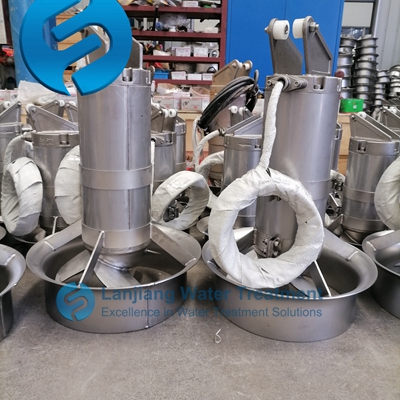The calculation method of the power of the sewage mixer can be carried out according to different formulas and parameters, which are usually based on the principles of fluid mechanics, the geometry of the equipment, and practical operating experience. Here are some common calculation methods:

First, a formula based on density, flow rate, mixer type coefficient and liquid height
A common calculation formula is:
P=
3960
Density × flow rate × mixer type factor × liquid height
Among them:
The unit of density is kg/m³
The unit of flow is m³/h
The mixer type coefficient needs to be determined according to the mixer data book of the different model
The unit of liquid height is m
This formula takes into account the physical properties of the liquid (density and height) as well as the operating conditions of the mixer (flow rate and mixer type) to calculate the power required.
Second, based on liquid density, motor speed and propeller (or agitator) diameter formula
Another formula is:
P=
1000
K * rho * n
3
×D
5
Or simply:
P = rho * N
3
×D
5
Among them:
K is the coefficient
ρ is the liquid density (unit: kg/m³)
n or N is the motor speed (unit: RPM or RPM/SEC)
D is the diameter of propeller or agitator (unit: m)
This formula focuses on the mechanical properties of the mixer (speed and diameter) and the physical properties of the liquid (density), and estimates the power requirements of the mixer through the mathematical relationship between them.
Third, formula based on mixing strength and liquid volume
In specific occasions such as sewage treatment plants, the power of the mixer can also be calculated according to the mixing strength and liquid volume. The formula is:
P=E×V
Among them:
P is the power of mixer
E is the mixing strength (unit: W/m³, to be determined according to the actual process requirements)
V is liquid volume (unit: m³)
This method directly calculates the minimum power required by the mixer at a certain mixing strength by determining the mixing strength and liquid volume.
Fourth, other considerations
It should be noted that the above formula only provides a theoretical calculation method, and other factors need to be considered in practical applications, such as the efficiency of the mixer, power factor, motor power, etc. In addition, the shape of the agitator, the distance between the agitator and the tank, and the shape of the blade will also have an impact on the actual power requirements.
Therefore, when choosing a sewage mixer, it is necessary to conduct comprehensive consideration and calculation according to the specific situation to ensure that the selected equipment can meet the actual needs and have good operating results. At the same time, you can also refer to the technical manual provided by the equipment manufacturer or consult professionals for more accurate power calculation methods and selection recommendations.
Nanjing LanJiang Water Treatment Equipment Co.,Ltd manufactures equipment for wastewater treatment. We were established in 2001. Since then, we designed and produced submersible mixers, top entry mixers, aerators and other wastewater treatment equipment.
Post time:2024-07-30